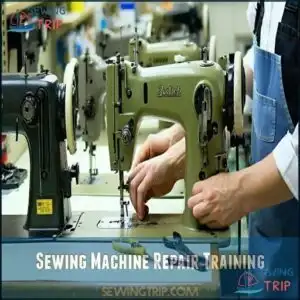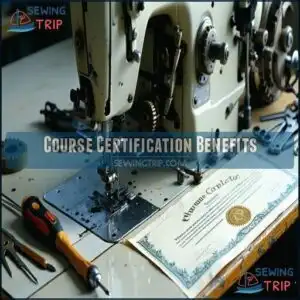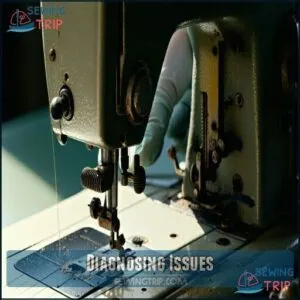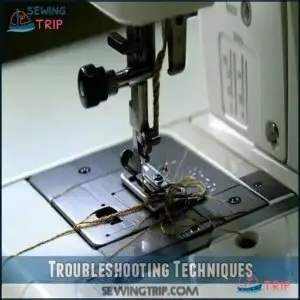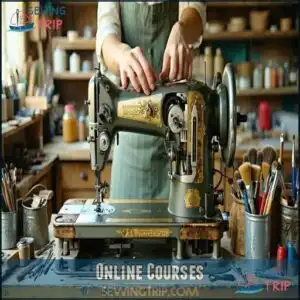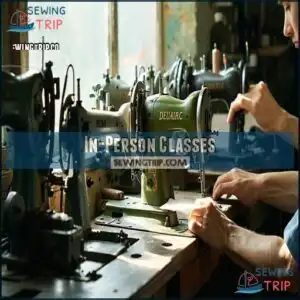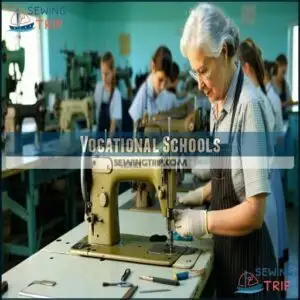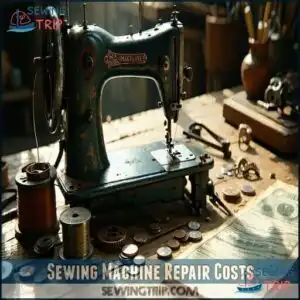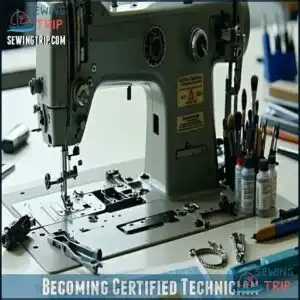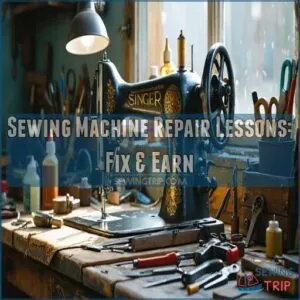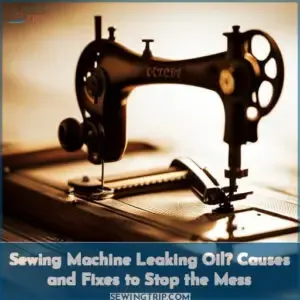This site is supported by our readers. We may earn a commission, at no cost to you, if you purchase through links.
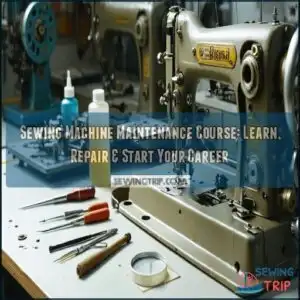
These hands-on programs teach you to diagnose weird noises, fix tension problems, and perform routine upkeep that manufacturers hope you’ll pay them for.
You’ll learn proper cleaning techniques, part replacement, and troubleshooting skills from experienced technicians who’ve seen every thread jam imaginable.
Most courses cover both mechanical and computerized models, with options ranging from weekend workshops to extensive certification programs.
The skills you’ll gain will save money and might open doors to a flexible side hustle or full-time career where you’re the hero who rescues beloved machines.
Table Of Contents
Key Takeaways
- You’ll learn essential skills like diagnosing weird noises, fixing tension problems, and performing routine maintenance that can save you costly repair bills.
- You’ll gain hands-on experience through practical training that covers both mechanical and computerized machines, with options ranging from weekend workshops to certification programs.
- You’re investing in a potential career path, as certified repair technicians can earn $10-25 per hour in a field where skilled professionals are in high demand.
- You’ll need to consider various training options that fit your schedule and budget, with course fees ranging from $295 for basic courses to $3,200 for extensive programs.
Sewing Machine Repair Training
You’ll master essential repair techniques through our hands-on training with industry experts who’ll teach you to fix everything from stubborn tension problems to mysterious rattling noises.
Your certification opens doors to lucrative career opportunities in a field where skilled technicians are as rare as sewing machines that never jam, providing a chance for a successful career.
Repair wizards are scarce gems in a world where every machine eventually fumbles—your skills will be treasured gold.
Comprehensive Course Details
When you enroll in a sewing machine repair course, you’ll discover a thorough curriculum designed to transform beginners into skilled technicians.
Our courses blend theory with practical application to guarantee thorough understanding. Regular maintenance can help prevent costly future repairs.
- Course curriculum covers both mechanical and computerized machines
- Qualified instructors with 10+ years of industry experience
- Detailed learning resources including textbooks and video tutorials
- 24/7 support availability throughout your training journey
Hands-on Practice
Why read about fixing machines when you can actually take them apart?
During hands-on practice sessions, you’ll disassemble various model variations, gaining intimate tool familiarity that textbooks can’t provide.
Your sewing machine maintenance training includes repair simulations of common problems, where practical application cements your sewing machine repair skills.
You’ll tackle actual maintenance challenges under supervision, transforming theoretical knowledge into hands-on experience that makes the repair course truly effective, providing practical application.
Industry Expert Mentorship
The guidance of seasoned professionals transforms your sewing machine repair journey from fumbling with parts to mastering intricate mechanisms.
You’ll receive personalized learning from experts who’ve spent decades in the sewing machine repair industry.
Your mentorship includes:
- One-on-one troubleshooting sessions with certified technicians
- Real-world career insights about running a repair business
- Networking opportunities with established sewing machine repair professionals
Course Certification Benefits
You’ll boost your career prospects and client trust with our globally recognized sewing machine repair certification that validates your expertise.
Your new credentials will open doors to repair shops, manufacturing units, and lucrative self-employment opportunities where certified technicians are in high demand.
Role Of Effective Communication
During your sewing machine technician training, communication becomes the thread that binds your technical skills to real-world success.
You’ll master how to explain complex repairs using simple terms that clients understand.
| Communication Skill | Application | Benefit |
|---|---|---|
| Active Listening | Understanding client concerns | Accurate diagnosis |
| Clear Instructions | Explaining maintenance steps | Client trust |
| Conflict Resolution | Handling repair expectations | Repeat business |
Your certification validates not just technical ability but also your communication toolkit—essential when discussing tension problems or bobbin issues with anxious owners.
Benefits Of Team Collaboration
While learning sewing machine repair, you’ll discover that team collaboration multiplies your skills exponentially.
Team collaboration in repair training isn’t just helpful—it’s the secret multiplier that turns novices into masters overnight.
Working alongside fellow students in your sewing machine maintenance course creates a knowledge-sharing environment where diverse perspectives tackle complex problems.
You’ll troubleshoot stubborn issues faster, benefit from others’ experiences, and develop innovative repair techniques you’d never discover alone.
This collaborative approach gives you confidence when facing unfamiliar machines, ultimately boosting your efficiency and career prospects.
Challenges Of Remote Work
While team collaboration boosts learning outcomes, remote work in your sewing machine maintenance course brings its own hurdles.
You’ll face these common challenges:
- Isolation Blues – missing hands-on demonstrations
- Communication Barriers – delayed feedback on repair techniques
- Tech Troubles – connectivity issues during live tutorials
- Blurred Boundaries – balancing practice time with home life
- Motivation Struggles – staying focused without classroom energy
Online courses require extra discipline, but YouTube tutorials and maintenance tips can supplement your learning journey.
The flexibility of online sewing classes allows you to work at your own pace.
Sewing Machine Repair Skills
You’ll master essential skills to diagnose and fix common sewing machine problems, from jammed needles to tension issues, without breaking a sweat.
With hands-on practice in our course, you’ll soon be taking apart and reassembling machines with the confidence of a seasoned pro.
Diagnosing Issues
With your certification in hand, you’ll tackle the detective work of sewing machine diagnosis.
You’ll learn to spot the culprits behind common sewing problems – from skipped stitches to tension imbalance.
Our course teaches you to identify needle problems, motor issues, and feed problems that affect stitch quality.
You’ll develop a diagnostic sixth sense, often hearing what’s wrong before you even see it!
Troubleshooting Techniques
Now that you’ve mastered diagnosing issues, let’s tackle the hands-on solutions.
You’ll learn to fix jammed needles, tension problems, and feed issues through practical step-by-step techniques.
Our sewing machine troubleshooting modules show you how to adjust tension properly and correct timing errors that cause those frustrating stitch quality problems.
Proper adjustments can improve sewing machine tension.
You’ll even tackle motor malfunctions that once seemed impossible—soon you’ll be saying, "That noise? Fixed it in five minutes!
Machine Maintenance
At the heart of every reliable sewing machine lies proper maintenance. You’ll learn essential upkeep skills that extend your machine’s life and prevent costly repairs.
- Regular cleaning of lint and debris from bobbin area and feed dogs
- Identifying critical lubrication points for smooth operation
- Recognizing when part replacement is necessary before catastrophic failure
- Implementing preventative maintenance schedules based on usage
- Proper storage solutions to protect your machine between projects
To guarantee longevity, follow these sewing machine maintenance tips. This will help ensure your machine operates smoothly and prevent costly repairs over time, allowing for smooth operation.
Career Opportunities Ahead
You’ll access a wealth of job opportunities with your sewing machine repair skills, including high-demand positions in service centers, manufacturing facilities, or even your own profitable repair business.
With over 90 million machines needing annual service and repair technicians earning between $10-25 per hour, you’re stitching together the perfect pattern for a secure and rewarding career.
Job Market Demand
You’ll step into a field with rock-solid demand as a sewing machine repair technician.
The textile industry’s recent surge needs qualified mechanics, with Iowa boasting a 20% employment rate per 1,000 people. Though projections show a slight -3.10% decline over five years, specific regions like Montana and North Dakota (14% per 1,000 people) offer promising opportunities.
Your certification’s value shines brightest in these high-demand areas! To validate these skills and enhance credibility, consider obtaining relevant certifications.
Self-Employment Options
With sewing machine skills in high demand, starting your own repair business could be your ticket to freedom.
You’ll control your schedule while putting your technical expertise to work.
Here’s what you’ll need for a successful sewing machine repair business:
- A dedicated workspace with proper lighting and storage
- Basic marketing tactics to attract your first clients
- Clear pricing strategies that reflect your expertise
- Essential inventory management for parts and supplies
Salary Expectations
After establishing your own repair business, you’ll want to understand what you can earn.
As a sewing machine repair technician, you can expect to make around $15.42 per hour—ranging from $10 to $25 depending on your experience impact and location variance.
With less than five years in the field, annual earnings can reach $30,000.
Certification premium often boosts your earning potential, making negotiating salaries easier.
Finding Repair Training Courses
You’ll find plenty of repair training options through certification programs, vocational schools, and even YouTube tutorials to fit your learning style and schedule.
Whether you choose the Fix Sewing Machines Institute or Singer’s workshops, you’re just a stitch away from mastering the art of sewing machine repair.
Online Courses
Now that you’ve explored career possibilities, let’s talk about fitting training into your busy schedule.
Online sewing machine repair training offers remarkable flexibility with 24/7 accessibility to courses and tutorials. You’ll enjoy self-paced learning through interactive modules and video demonstrations.
Many programs provide thorough reference materials and support at lower costs than traditional classes. You can even find a suitable repair course online to enhance your skills.
The Fix Sewing Machines Institute and other providers offer structured online courses with recognized certifications—perfect for maintaining your current job while building new skills.
In-Person Classes
Face-to-face sewing machine repair training offers irreplaceable benefits you won’t find online.
During in-person classes, you’ll receive immediate feedback when your threading technique needs correction. Instructors demonstrate complex repairs right before your eyes, making hands-on learning more effective.
You’ll also build valuable networking opportunities with fellow enthusiasts and professionals. Many repair classes provide certification upon completion, giving your new skills official recognition that clients trust.
You can find various repair training classes online, which can be a useful resource to supplement your learning.
Vocational Schools
While in-person workshops offer immediate feedback, vocational schools provide structured sewing machine repair training with proper accreditation.
You’ll find thorough program curriculum that prepares you for certification as a sewing machine technician.
Vocational schools stand out for three key reasons:
- Instructor qualifications typically include years of industry experience
- Hands-on training with various machine types
- Higher placement rates through established industry connections
Look for schools requiring a high school diploma and offering specialized programs like those at Fix Sewing Machines Institute.
Sewing Machine Repair Costs
You’ll find investing in sewing machine repair surprisingly cost-effective when considering the potential return on your investment.
From course fees ranging from $295 to $3,200 to essential tools and possible business startup expenses, understanding these costs now will save you from wallet shock later!
Course Fees
Now that you’ve found your ideal training program, let’s talk money.
Sewing machine repair certification costs vary widely – from $295 for basic domestic lockstitch courses to $3,200 for extensive programs.
Most schools offer payment options and financing available.
Compare tuition carefully – the cheapest isn’t always best! Check what’s included in materials and review refund policies before committing to sewing machine maintenance certification.
Tool Expenses
Beyond course fees, you’ll need to invest in essential tools for sewing machine repair.
A basic starter kit costs $100-300 and includes screwdrivers, tweezers, needle-nose pliers, and lubricants.
Professional-grade tool kits run $300-800 with specialized components for different machine types.
Tool organization systems ($30-100) and maintenance supplies ($25/year) are additional expenses.
"You can’t fix a Ferrari with a bike wrench," as repair pros say, highlighting the importance of proper tools for the job, which can be a significant investment.
Business Startup Costs
Setting up your sewing machine repair business doesn’t have to break the bank.
Your initial investment will vary based on how big you want to start:
- Minimal startup: $2,000-$5,000 (home-based with basic tools)
- Mid-range launch: $5,000-$15,000 (small shop with inventory)
- Full-service operation: $15,000-$30,000 (dedicated location, extensive inventory, marketing expenses)
Insurance costs typically run $500-$1,500 annually depending on your coverage. Starting a sewing machine repair business with a minimal startup can be a viable option.
Becoming Certified Technician
You’ll transform from hobbyist to professional with a globally recognized certification that instantly boosts your credibility and job opportunities.
Even the most stubborn, tangled-up machines won’t stand a chance against your new skills, opening doors to repair shops, manufacturing positions, or your very own sewing machine repair business, which can lead to a successful sewing machine repair career.
Certification Process
While managing your sewing machine repair costs, you’ll also need to map out your certification journey.
The sewing machine certification process typically starts with selecting a reputable sewing machine technician program.
You’ll complete application forms, verify prerequisites needed (usually a high school diploma), and enroll in a structured course.
Most sewing machine repair programs offer certification validity for 2-3 years with renewal requirements to keep your skills current.
Exam Preparation
The road to successful sewing machine certification exams requires thoughtful preparation.
Your study plan should include:
- Practice with diverse question types using quality study resources
- Daily time management with focused 30-minute sessions
- Understanding retake policies before attempting your first exam
- Building confidence through hands-on practice with actual machines
Most sewing machine technician programs offer two exam retakes, so don’t panic if you stumble initially.
Certification enhances your marketability, especially with industrial sewing employers, and is a key factor in successful sewing machine certification exams that require thoughtful preparation and hands-on practice.
Career Advancement
Climbing the career ladder in the sewing machine repair industry requires strategic planning.
After certification, pursue advanced training to expand your expertise.
Join industry associations for networking opportunities and mentorship from seasoned technicians.
Document your successful repairs to negotiate higher salaries.
Many certified technicians advance to training roles or open their own shops.
The industry growth creates abundant promotion strategies for dedicated professionals, leading to opportunities such as opening their own shops, which is a key part of career advancement.
Frequently Asked Questions (FAQs)
What can I do with a sewing machine repair technician training program?
You’ll access repair shop careers, self-employment opportunities, and service center positions.
You can fix diverse machine models, earn $15-25 hourly, and build a profitable business with 35 million potential customers needing annual maintenance, which can lead to a highly successful career.
What is a sewing machine maintenance class?
A sewing machine maintenance class teaches you how to clean, oil, and troubleshoot your machine for peak performance.
You’ll learn basic repairs and preventative care to keep your stitches perfect and extend your machine’s life.
How often do sewing machine repair classes start?
For most institutes, classes start every two months, with Singer workshops filling up quickly.
You’ll need to register early!
Fix Sewing Machine Institute and White Sewing Center offer regular training schedules.
Where can I learn how to repair a sewing machine?
Jennifer saved hundreds by learning to fix her own machine.
You can learn at Fix Sewing Machines Institute, White Sewing Center, or through online courses, vocational schools, apprenticeships, or Singer’s repair training workshops.
This allows individuals to acquire new skills and become proficient in sewing machine maintenance and repair.
How much does a sewing machine repair class cost?
You’ll find sewing machine repair classes ranging from $295 for a 2-day domestic lockstitch course to $3,200 for extensive programs.
Online options tend to be more affordable than in-person training with hands-on practice.
Where can I get a sewing machine repair course in Maryland?
You’ll need to try online options like Fix Sewing Machines Institute or Singer training workshops since Maryland doesn’t have local in-person courses.
Virtual classes let you learn while keeping your day job, which can be a significant advantage.
Can I repair vintage sewing machines?
Yes, you can absolutely repair vintage sewing machines.
With the right training and tools, you’ll master their simpler mechanical systems.
They’re often sturdier than modern machines and replacement parts are surprisingly available through specialty suppliers, making them a great option for those looking to repair vintage sewing machines.
How often should machines be serviced?
Like a neglected garden wilting without rain, your sewing machine needs regular TLC.
You should service it every 6-12 months, depending on usage.
Heavy users? Every 6 months.
Occasional sewists? Yearly’s fine.
Which tools are absolutely essential?
You’ll need screwdrivers (flathead and Phillips), tweezers, lint brush, cleaning cloths, sewing machine oil, and a tension gauge. Don’t forget needle-nose pliers and a flashlight for those hard-to-see areas.
Do computerized machines require special training?
Computerized machines definitely require specialized training due to their electronic components and software systems. You’ll need to learn diagnostics, programming interfaces, and electronic troubleshooting alongside traditional mechanical repair techniques.
Conclusion
Taking a sewing machine maintenance course transforms frustrating breakdowns into fixable problems.
You’ll save money, extend your machine’s life, and possibly discover a rewarding career path.
Whether you choose online training or hands-on workshops, the skills you’ll gain are invaluable.
Don’t let your creative projects stall because of mechanical issues—invest in yourself.
Your future self will thank you when you’re confidently troubleshooting instead of panicking.
Ready to breathe new life into your faithful stitching companion?
- https://sewingbecomeasy.com/how-to-become-a-sewing-machine-repair-technician/
- https://www.sewingmachinesinstitute.com/single-post/crafting-a-career-the-impact-of-industrial-sewing-machine-repair-courses
- https://cam.masstech.org/sites/default/files/2024-07/Preparing%20the%20Advanced%20Manufacturing%20Workforce%20A%20Study%20of%20Occupation%20and%20Skills%20Demand%20in%20the%20Advanced%20Fabric%20and%20Fiber%20Industry.pdf
- https://bigfuture.collegeboard.org/careers/sewing-machine-operator/income-and-hiring
- https://www.zippia.com/sewing-machine-mechanic-jobs/trends/

